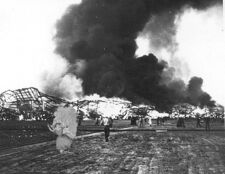Hydrogen oxide

Hydrogen oxide is a valuable material that nearly no one pays for. It has myriad uses in industrial applications, in sports, and in cleanups, such as of dishes. It is a vital part of having sex. Improper storage of hydrogen oxide has led to places getting moldy and dirty.
History[edit]
Hydrogen oxide appeared on Earth billions of years ago, halfway during the Parched Epoch, shimmering and glittering, often diffused into a glossy mass of vapor, only to condense and fall back to Earth once more.
Early in its tenure on Earth, hydrogen oxide developed an affinity with sodium chloride, the result of which was the oceans. In a relative instant, lightning struck and various odd life forms resulted, swimming around in the muck and looking for a breath of fresh air.
The more sensible of these life forms got out of the Drink and walked on land — but never far from hydrogen oxide which, it turns out, is highly habit-forming. Humans got the furthest away, drilling into the ground to obtain their hydrogen oxide. The most advanced humans, though not advanced enough to get far away from Holyoke, Massachusetts, used hydrogen oxide to power great industrial mills and, later, gigantic recreational parks of the stuff.
The great divide[edit]
Eventually hydrogen separated from oxygen. The latter proved eminently breathable and was welcome everywhere. The former proved eminently explosive and was stuffed into dirigibles and blimps, in the days before the Transportation Security Administration. Separating out the hydrogen is referred to as "fission energy," whose great potential was demonstrated by the Hindenburg.
The Hindenburg episode (pictured) was viewed as unnecessarily flamboyant, and many neighbors complained. Thereafter, mankind concentrated on energy without fission ("fusion energy"). The reunited molecule was heated to a gas and powered railroad trains and hair curlers. In the former application, the pressure of gaseous hydrogen oxide drove pistons back and forth until they got tired of it and whined.
By now, bosses were throwing troublemakers into hot vats of hydrogen oxide, and numerous hydrogen oxide accidents were reported, leading to the building of hydrogen oxide dispersal systems. These are divided into storm sewers and sanitary sewers. The thirsty traveler needs to learn how to distinguish them.
In post-war life, tract houses were built so that hydrogen oxide would be delivered right inside the house, hot, cold, or explosive.
Technical details[edit]
Hydrogen oxide naturally obeys the disparaging command to "get bent." Wikipedia states that the angle is exactly 104.45°, though they go on to call it a disturbing case of homophobia. The resulting shape means that when the microwave oven shouts, "Dance, cowboy!" the hydrogen oxide molecule obeys it as well.
The bend is fortuitous, because it means that lakes freeze from the top down and not from the bottom up, a state of affairs in which ice hockey would take considerably longer to play out regardless of innovative tie-breaker formats, likewise marine evolution.
Related substances[edit]
Dihydrium monoxide is related to hydrogen oxide, by being the same thing. The boy in class in a vest with his hand raised calls it dihydrium monoxide because his parents smile and coo whenever he uses a long word they have never heard before. However, the bonding tendencies of the hydrium and the oxide ensure that there are always "two girls for every boy" (Beach Boys) and in fact it is difficult to get anything but Di, Mon.
A fleeting exception is hydrogen peroxide (H₂O₂), the effect of the same unstable O-O emoticon that gives us castling king-side, and the cause of many platinum blondes.
Uses[edit]
Hydrogen oxide is used in the Summer Splash ceremony, the Clean-the-Kitchen, Clean-the-Clothes, and Clean-the-Dishes rituals, numerous industrial applications, sex, romance, relaxation, and just plain goofing off. It is also used alarmingly heavily in the bathroom and on farms, leading to fears of ecological distress and a hydrogen oxide shortage.
Hydrogen oxide, potentially troublesome as it is, will be around for a while yet — almost as long as ecological distress.

